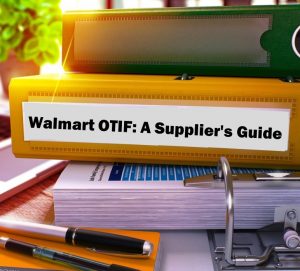When suppliers enter into partnerships with retailers, which delivery method is best: prepaid or collect? The short answer is it depends!
The true answer is what we’ll explain in this article. Prepaid and collect delivery both have advantages and disadvantages depending on the supplier’s business, the retailer receiving the shipments, delivery expectations, penalties, budget concerns, and more.
We’ll begin by defining basic shipping terms and then deep dive into what suppliers should consider when deciding to deliver collect vs. prepaid.
Collect vs. Prepaid
Shipments that are sent collect require the receiving party to pay all shipping charges. Shipments that are sent prepaid require the party shipping the freight to pay all shipping charges.
In this article, we will explore more than the simple differences between collect and prepaid shipping. We’ll look at the advantages of each, how it impacts Walmart suppliers, and free resources to help suppliers decide which method is best for their business.
Overview of Shipping Terminology
If you are a new supplier, or if you’re new to the logistics team of your company, some of the jargon can be overwhelming! Besides knowing the difference between collect and prepaid, there are other terms to be familiar with as you go into negotiations with clients. Some common ones include:
- 3PL: 3PL is short for “third-party logistics.” Companies will contract with a 3PL in order to outsource shipping, inventory management, and warehousing.
- Bill of Lading (BOL): The bill of lading is the overall terms and conditions for the shipment. The BOL is where freight and payment terms are defined.
- Cash on Delivery (COD): Cash on delivery requires the shipping party to collect payment upon delivery of the freight.
- Free on Board (FOB): Free on board is the “hand-off” point between the buyer and seller in the supply chain. FOB is literally the point where ownership of the freight is transferred from the shipping party to the receiving party. In negotiation for shipping and receiving, FOB will be used in conjunction with how the freight will be paid as well as where ownership changes:
- FOB Destination Point (Freight Prepaid): The party shipping the freight is responsible for and retains ownership of the freight through delivery. The shipping party also pays all fees required for the shipment.
- FOB Destination Point (Freight Collect): The shipping party is responsible for and retains ownership of the freight until it arrives at its final destination. Upon arrival, the buying or receiving party pays for the transportation of the freight.
- FOB Shipping Point (Freight Prepaid): The buying or receiving party owns, assumes liability, and is responsible for the freight at the point of origin. The shipping party pays for the shipping of all goods.
- FOB Shipping Point (Freight Collect): The buying or receiving party owns, assumes liability, and is responsible for the freight at the point of origin. They buying party also pays for the shipping of all goods.
- Third-Party Freight: Third-party freight means that the company responsible for paying the freight bill is not the company receiving or shipping. It usually means an outside logistics company is paying to transport the shipment from a supplier to the receiving party.
What Is Freight Collect?
When a company chooses to ship freight collect, the buying or receiving party assumes responsibility for all aspects of transporting the freight. The selling party simply has to prepare the freight for pickup as agreed to on the purchase order. The buying or receiving party may have its own logistics system to ship collect deliveries or contract with a third-party carrier.
What Is Freight Prepaid?
When a company chooses to ship freight prepaid, this means they as the shipping party assume responsibility for all aspects of transporting freight to the buying or receiving party. The shipping party takes on all logistical responsibility, whether using their own system or partnering with a 3PL. Costs associated with partnering with a 3PL fall on the shipping party. Any penalties or fines from the receiving party will still go back to the shipping party, not the 3PL.
Freight Collect Pros and Cons
When deciding between using the collect vs. prepaid shipping methods, one isn’t superior to the other. Which method will be most beneficial depends largely on the shipper’s business and the requirements set up by the receiver. We’ll first look at the pros and cons of shipping freight collect:
Pros of Freight Collect
- Less responsibility – The selling party is essentially handing all the transportation work over to the receiving party. For the selling party’s bottom line, this can translate into fewer staff needed, lower costs involved, and fewer resources needed in the fulfillment process.
- Fewer compliance issues – The selling party does not have to worry about delivery non-compliance. Sellers only have to ensure orders are accurate and ready to be picked up by the appointment time on the purchase order. Not having to deal with delivery arrival times and other compliance issues means not having to pay additional penalties.
- Transportation costs – When using freight collect, shipping parties will agree upon transportation terms usually once a year with clients. This eliminates unforeseen problems popping up unexpectedly in shipping costs.
Cons of Freight Collect
- Giving up control – In using the freight collect method, the shipping party relinquishes a good deal of control. More than controlling the physical shipment of the freight, the seller also give up control of shipping times, costs, carrier choice, and some supply chain visibility.
- Not managing delivery times – Not having to deal with delivery time compliance may seem like a pro, but giving up this control can easily hurt a seller’s bottom line. While clients may have high expectations and guidelines for how and when a seller delivers freight, they may not hold themselves to the same expectations. This can potentially hurt a seller’s on-shelf availability and result in missed sales.
- No delivery cost flexibility – In negotiating collect shipping agreements, the receiving party will work the cost of transportation into the contract. By locking into this charge (usually negotiated once a year), the seller loses any flexibility to save on shipping costs should opportunities present themselves throughout the year.
Freight Prepaid Pros and Cons
As stated previously, one method is not necessarily better than the other in all cases. Here’s a look at the pros and cons of shipping freight prepaid:
Pros of Freight Prepaid
- Cost control – When shipping freight prepaid, the seller will determine the cost of shipping. Since the seller assumes the liability of freight costs, they can negotiate how much the receiving party will pay for shipments.
- Control over special shipping – Freight prepaid means the shipping party legally owns the freight while it is in transit. Ownership then transfers to the buying or receiving party once the shipment has been delivered. This method is most beneficial to businesses buying and selling fragile merchandise, or freight that requires a custom delivery method.
- Ease of upfront payment – Sellers using freight prepaid enjoy a relatively upfront method of payment. This means that before the freight is shipped to the client, most of the shipping costs are covered. For the shipper, this cuts back added costs of potential returned freight.
Cons of Freight Prepaid
- Added responsibility – Full responsibility for shipping falls on the shipping party. While complete control can be a pro, the penalties for non-compliance also come with it! When small companies use a third-party carrier, late charges will still go back to the shipping company, not the carrier.
- Added costs – More responsibility in any area brings more costs, even if the work is outsourced. Companies choosing to ship freight prepaid still have to monitor performance, even when working with a 3PL. This requires the company to add labor and resources for everything from contract negotiation, to research, and more.
- Choosing a logistics partner – Not every seller has their own shipping fleet or chain of warehouses. Many will need to contract with a 3PL, consolidator, or carrier. Mistakes made by a third party will result in penalties for the seller. This means lost sales, reduction in shelf space, or even having items removed from the modular all together. Time and research have to be put into partnering with the third party that will represent the seller well
Implications for Walmart Suppliers
As a Walmart supplier, should you choose collect or prepaid? If you are not currently delivering to Walmart, you need to know about On Time In Full (OTIF).
OTIF is Walmart’s compliance measure of how a supplier’s freight arrives at a Walmart store or distribution center. As its name states, Walmart is asking two questions of each supplier delivery: “Did the freight arrive on time?” and “Did the freight arrive in full?”
When supplying to Walmart, meeting the OTIF requirements should be a major factor in choosing between delivering prepaid or collect. Current suppliers are using both methods and even partnering with 3PLs to stay compliant with Walmart guidelines.
Conclusion
Collect and prepaid freight both have advantages, depending on your business need and the clients you serve. If you have questions about which method will work best for your business with Walmart, check out our free resources for suppliers:



